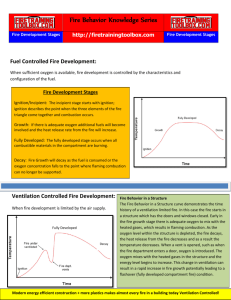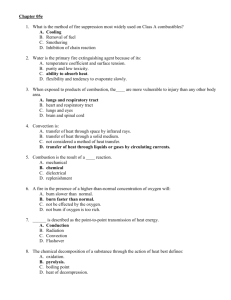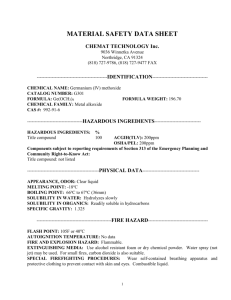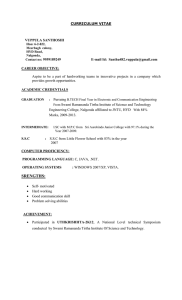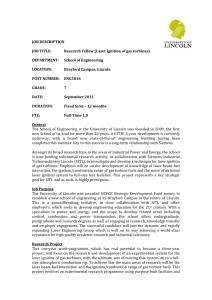Application of a new diagnostic method to observe pre-ignition phenomena
advertisement
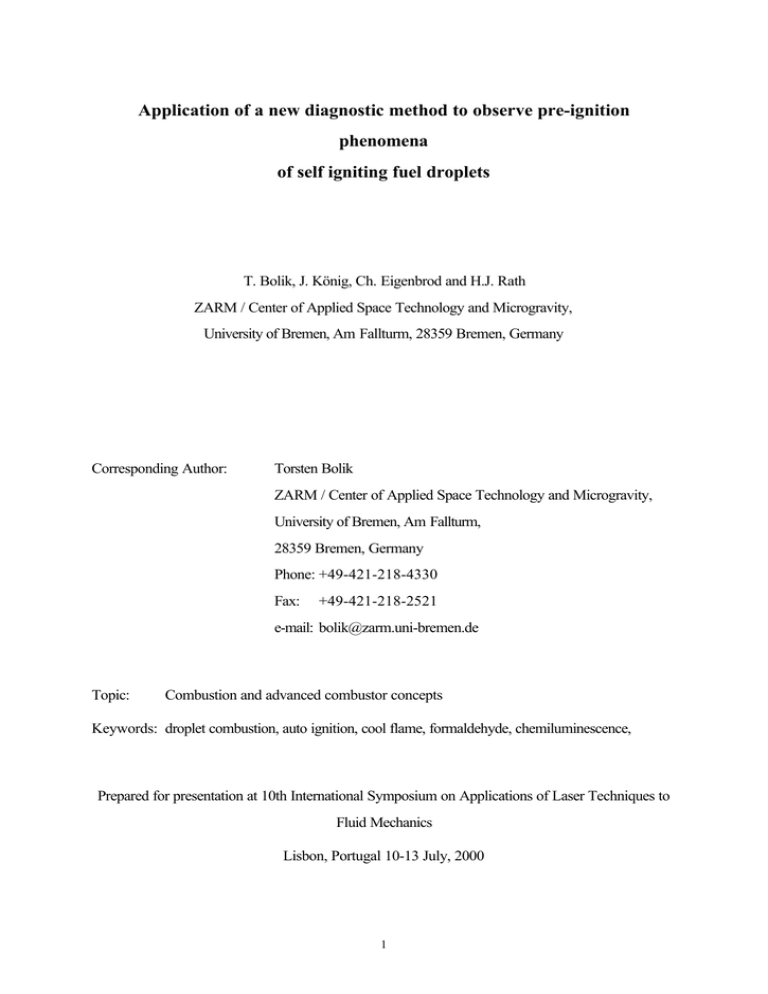
Application of a new diagnostic method to observe pre-ignition phenomena of self igniting fuel droplets T. Bolik, J. König, Ch. Eigenbrod and H.J. Rath ZARM / Center of Applied Space Technology and Microgravity, University of Bremen, Am Fallturm, 28359 Bremen, Germany Corresponding Author: Torsten Bolik ZARM / Center of Applied Space Technology and Microgravity, University of Bremen, Am Fallturm, 28359 Bremen, Germany Phone: +49-421-218-4330 Fax: +49-421-218-2521 e-mail: bolik@zarm.uni-bremen.de Topic: Combustion and advanced combustor concepts Keywords: droplet combustion, auto ignition, cool flame, formaldehyde, chemiluminescence, Prepared for presentation at 10th International Symposium on Applications of Laser Techniques to Fluid Mechanics Lisbon, Portugal 10-13 July, 2000 1 Application of a new diagnostic method to observe pre-ignition phenomena of self igniting fuel droplets T. Bolik, J. König, Ch. Eigenbrod and H.J. Rath ZARM / Center of Applied Space Technology and Microgravity, University of Bremen, Am Fallturm, 28359 Bremen, Germany Abstract t=50ms t=500ms t=1000ms t=1500ms t=2000ms A powerful diagnostic method based on chemiluminescence of formaldehyde to observe staged ignition phenomena in the field of droplet combustion was developed and successfully applied. Chemically excited formaldehyde (HCHO*) was used as a excellent natural tracer for low temperature reactions. The faint blue luminescence was utilized to observe pre-ignition phenomena of self igniting fuel droplets. Interaction effects of neighbored selfigniting n-decane fuel spheres were studied in microgravity conditions and compared to single droplet results. Real weak signals became detectable with a sufficient quantum of efficiency by the developed intensified camera (ICCD) concept. The system consist of a proximity focused intensifier with one MCP of second generation with 25 mm diameter and a bi-alkali photocathode on quartz glass. The photocathode is combined with the phosphor screen type P43 and coupled by fiber optics to the CCD with a 256x256 resolution, max. frame rate of 200 f/s and 8-bit resolution. Wavelengths from 200 to 550nm are detectable with a sufficient quantum of efficiency. For systems evaluation data derived from chemiluminescence monitoring were compared with those from planar laser induced fluorescence (LIF) of formaldehyde excited at 352,2nm by means of an XeF-Excimer Laser. The results derived in normal gravity are discussed. Beyond that all combustion experiments observed by chemiluminescence were done in microgravity conditions at the 4,7s Drop Tower Bremen and were performed with a fixed droplet size of 1,5mm, varying mid spacings and ambient temperatures and pressures. Low temperature reaction zones were observed and regions with an individual cool flame behavior and also common enveloping cool flame zones were found. The dynamic of oscillating coolflames well known from gaseous flames became visible. It was found that droplet spacings exist, that either promote or inhibit hot ignition. An excerption of these findings are displayed to confirm the performance of this new diagnostic method. This project was done to support the development of numerical models for fuel spray auto-ignition experiments. The experimental database could be improved and the work demonstrate that numerical models for ignition of spray systems have to consider the complex interaction behavior of self igniting fuel droplets. t=2500ms Figure 1: Cool flame chemiluminescence of two interacting droplets up to hot ignition [microgravity, n-decane, 1,5mm droplet size, 3,5mm droplet spacing, T=750K, p=1bar, max. MCP amplification, 10ms exposure time, triple image average] t=2560ms 2 Introduction The knowledge about spray ignition phenomena is of highly fundamental and practical interest [1]. The massive use of liquid fuels in modern gas turbine engines emphasize the significance of these understandings. The combustion performance is strongly affected by the fuel preparation processes, influenced by the physics of atomization of liquid fuel, droplet movement, evaporation, mixing of fuel vapor and air and by the evolution of chemical reactions generating intermediate species until hot ignition occurs. In the development of new combustion concepts arguments of ecological and economical sense are contradictory. On one hand the thermal efficiency and specific power output are coupled to the compressor ratio and on the other hand increasing pressure and temperature is contrary to the requirements of lowering the thermal produced NOx emissions from gas turbines. From this point of view the lean premixed prevaporized (LLP) combustion technique is one of the most forward looking concepts. Auto ignition delay times of a fuel-air mixtures will decrease with growing pressure and temperature, so that premixing time is limited. In the opposite direction an ideal homogeneous premixing needs time and spontaneous ignition must be avoided. With this background it is necessary to improve the knowledge about interactions between droplets arranged in a spray formation, evaporation in heterogeneous liquid-gas flows and chemical reactions in the combustor premixing zone under a wide range of conditions. The approach of this work is to study these phenomena from the fundamental point of view. Auto ignition experiments on single and two interacting droplets in microgravity and normal gravity conditions were done. In microgravity conditions effects of buoyancy are eliminated and observations of the complex ignition processes can take place in simplified ambient conditions [2]. For the first time effects on the staged self ignition processes with variable droplet spacings and ambient pressures were studied. The low temperature reaction of cool flame chemistry in alkanes is centered around the reversible formation of peroxy radicals (RO2) [3], in a sensitive equilibrium status. For this reason special attention must be considered on applying a non intrusive measuring techniques. A chemiluminescence technique was developed and used to detect cool flame phenomena. In order to support the development numerical models [4] for fuel spray auto ignition in the nearest future experiments examining the ignition process of single- and two interacting droplets of n-decane were done. Experimental Setup and Procedure All experiments were done at the 4,7s ground based short-term microgravity laboratory of Drop Tower Bremen. The actual microgravity laboratory is a cylindrical drop capsule at a diameter of 800 mm with a length of 2,4m. Inserted platforms, held in aluminum profiles, form a modular drop capsule structure. The essential part of the experimental hardware is the pressurized and heated reaction chamber (Fig. 2). The inner volume of the vessel that is licensed up to 80bar is separated into a thermally isolated resistance heated furnace and a cold section below. While the hot part is the reaction chamber, the cold section contains the video controlled sphere fueling system and the elevator for rapid lifting the spheres into the furnace. In order to minimize interferences of the suspender with spheres a 150µm thin Sapphire fiber was used. The traveling distance into the furnace is 140mm. The transition time is 150ms. For dynamic reasons a quasi droplet made of porous ceramic spheres with a porosity of 40% and a diameter of 1,5mm was developed. The furnace as well as the vessel are equipped with 4 windows allowing the visual observation of the ignition process. According to the experimental requirements an intensified camera (ICCD) concept was developed. The system consist of a proximity focused intensifier with one MCP of second generation with 25 mm diameter and a bi-alkali photocathode on quartz glass. The photocathode is combined with the phosphor screen type P43 and coupled by fiber optics to the DALSA Scan Area Camera CAD1 with a 256x256 resolution, 16µm square pixels and a 8-bit resolution, so wavelengths from 200 to 550nm are detectable with a sufficient quantum of efficiency. A spectral filtering against background radiation from the furnace walls was dispensable. The first and total ignition delay time are measured with 100 frames/second as the time between the droplets arrival at the upper end-position and the first light occurrence of cool- and hot flame respectively. The experiment is initiated 350ms after release of the drop capsule in order to give natural convection, driven by imperfection in thermal distribution, sufficient relaxing time. Lifting down the spheres is initiated 200ms before the capsules braking status for mechanical safety reasons. Therefore exactly 4s remain to perform µg experiments. 3 ø193,7 A 664 A A-A electrical interface heater ceramic isolation window pressure window plattform heat exchanger flange fuel droplet CCD-camera fuelsystem and elevator fixture Fig. 2: High temperature and high pressure reaction chamber to observe staged ignition phenomena on single and Two interacting droplets Results and discussion The present experiments are focused on the detection of the two stage ignition process and cool flame behavior with a non intrusive observation system. In this sense usually two methods have been applied in the past. An often used measurement technique is the Michelson Interferometer [5, 6] to visualize temperature gradients in the reaction zone. As the interferometer viewfield is extremely sensitive to disadjustments, this method could only give suitable data for observation zone smaller than a diameter of 20mm. A recent work [7] presents the planar laser induced fluorescence (LIF) of formaldehyde as an excellent natural tracer to detect the distinct stages of autoignition. Fluorescence of formaldehyde was induced by an excitation at 352,2nm by means of a XeF-Excimer laser. Figure 3 compares the technique of LIF (pictured right) with the method of luminescence (pictured left) applied on a cool flame of a 5mm n-heptane droplet (fuel drenched porous sphere) in normal gravity. In the chosen ambient conditions of p=1 bar and T=673 Kelvin only a cool flame appears without the occurrence of an hot ignition. Due to the density of the evaporating gas a convective downward flow is established and heat release of the cool flame is insufficient to invert it. Applying the light-sheet technique of LIF-spectroscopy on droplets combustion and the adjacent gas phase, the sphere has to be protected from direct irradiation to avoid Mie-scattering. Disadvantageous thus causes excluding parts of the gas phase from laser excitation. Since the detected fluorescence is solely due to the electronic states populated by laser excitation, the entire amount of formaldehyde molecules present in the light sheet are captured in the resulting images. Since formaldehyde is a rather stable intermediate at temperatures up to ~900K even in the presence of oxygen, diffusion causes the detected concentration field of formaldehyde to grow far beyond the site of low temperature reaction. 4 fuel droplet 50ms 500ms 1000ms t0 + 60ms high 1500ms 2000ms low t0 + 500ms 2420ms 2560ms low intensity colour scale high 3030ms t 0 + 3000ms Figure 3: Cool flame observation by Chemiluminescence and Formaldehyde LIF [normal gravity, n-heptane, 5mm droplet size, T=673K, p=1bar] 3500ms >4000ms 5 Figure 4: Cool flame chemiluminescence on single and two interacting droplets [microgravity, n-decane, 1,5mm droplet size, single droplet, 3,5-5-6,5mm droplet spacing, T=750K, p=1bar, max. MCP amplification, 10ms exposure time] Detecting the chemiluminescence of formaldehyde with an intensified camera, fluorescence excitation of formaldehyde molecules is due to chemical reactions within the various pathways of low temperature oxidation. Since the fluorescence lifetime of the first excited states S1 is of order of tens of nanoseconds, the images obtained by this technique purely display the zone of formaldehyde formation, i.e. low temperature reaction activity. Advantageous, compared to the LIF-technique, there is no unobservable area in the gas phase close the droplet surface and the induced fluorescence of the stable and non consumed formaldehyde will no cover the low temperature reaction . The obtained images represent line of sight rather than two dimensional data. These examinations emphasize that the luminescence is a phenomena of the chemistry and is not caused by thermal effects. As expected for microgravity, figure 4 show the spherical formation of the cool flame tracing excited formaldehyde for ambient conditions of P=1 bar and T=750K. For the interacting droplet spacing investigated on, spot respectively axis symmetry could be observed. Hot ignition of the single droplet does not occur within the available experimental time of 4 seconds. 4000 ignition time [ms] 3500 750K 3000 2500 2000 total ignition time multi droplet 1500 first ignition time multi droplet first ignition time single droplet 1000 500 0 2 4 6 8 10 mid-spacing [mm] Fig. 5: total and first ignition time of n-decane / 1 bar / 750 K / d=1,5mm / microgravity Figure 5 displays the result for total and first ignition time over droplet mid spacing. In these experiment conditions the 5mm spacing promote and the 6,5mm inhibit the second stage of ignition. Similar effects on total ignition were known [8] from Experiment in normal and microgravity, but a detailed explanation does not exist and in the context of cool flame behavior either. With the presented new diagnostic method to observe pre-ignition phenomena an additional important step for fundamental understandings was done. For the first time interactions of cool flames were observed. While at a mid-spacing of 5mm both droplets burn in a common envelope we suggest that thermal effects of heat release affect the chemical reaction. As displayed for 6,5mm spacing the cool flame burns individually. With increasing mid spacing and forced breaking down of the common enveloped fuel field and cool flame interrelated cooling effects become dominant. It was observed that first and total ignition time of single droplets differ with considerable longer ignition times measured in the two droplet experiment. This phenomena must be considered as an appearance of increasing ignition time at the ignitable limit. Conclusion and perspectives A powerful measurement technique based on chemiluminescence to observe staged ignition phenomena in the field of droplet combustion was developed and successfully applied. Interaction of selfigniting n-decane fuel spheres with a size 1,5mm has been investigated by means of chemiluminescence to visualize staged ignition phenomena. It was found that droplet spacings exist, that either promote or inhibit hot ignition. In connection 6 with this observations a context to cool flame behavior is given. Common enveloped cool flame reaction zones were observed and with increasing mid spacings the break down to individual behavior became visible. Thus it is demonstrated that developing models for the ignition in sprays a complex interaction behavior of the individual fuel sources has to be considered. Technical relevance is given by LPP combusters concepts. In future more experiments have to be done to investigate on the complex interaction of droplets during multistage ignition. Especially experiments at higher pressures are scheduled with special attention to conditions of technical relevance. Acknowledgment The experiments were conducted within the limits of the joint national project Development and Research Program on Pollutant-Reduced Combustion Systems (DROP-COS) supported by the German Space Agency / DARA (now German National Aerospace Research Center / DLR). References 1. S. K. Aggarwal. „A review of spray ignition phenomena: Present status and future research“. Pro. Energy Combust. Sci. Vol. 24, pp. 565-600, 1998. 2. C. K. Law, G. M. Feath. „Opportunities and challenges of combustion in microgravity“. Pro. Energy Combust. Sci. Vol. 20, pp.65-113, 1994. 3. M.J. Pilling (Editor). „Chemical kinetic / Vol. 35 – Low-temperature combustion and autoignition”. Elsevier, Amsterdam-Lausanne-New York-Oxford-Shannon-Singapore-Tokyo, 1997. 4. S. Schnaubelt, M. Tanabe, C. Eigenbrod, H. J. Rath. „Verification of detailed simulations for two-stage ignition of single droplets by ignition radius“. “. Drop Tower Days, Hokkaido, OCT. 11-14, 1998. 5. M. Tanabe, T. Bolik, Ch. Eigenbrod, H. J. Rath, J. Sato, M. Kono. „Spontaneous ignition of liquid droplets from a view of non-homogeneous mixture formation and transient chemical reaction“. Twenty-Sixth Symposium (International) on Combustion / The Combustion Institute, Naples 1998. 6. T.Bolik, O. Essmann, Ch. Eigenbrod, H.J. Rath. „Experimental study of the autoignition in a two-droplet arrangement at JAMIC and ZARM“. Drop Tower Days, Hokkaido, OCT. 11-14, 1998. 7. J. König, Ch. Eigenbrod, T. Bolik, H. J. Rath, D. Grebner, D. Müller, W. Triebel. „Observation of two stage autoignition of n-heptane fuel-spheres by LIF of formaldehyde“ “. Twenty-Seventh Symposium (International) on Combustion / The Combustion Institute, Poster Presentation, 1998. 8. T. Kadowaki, K. Maruta, H. Kobayashi, T . Niioka. „Ignition experiments on droplet matrix in microgravity“. Microgravity sci. technol. IX/4, 1996. 7




